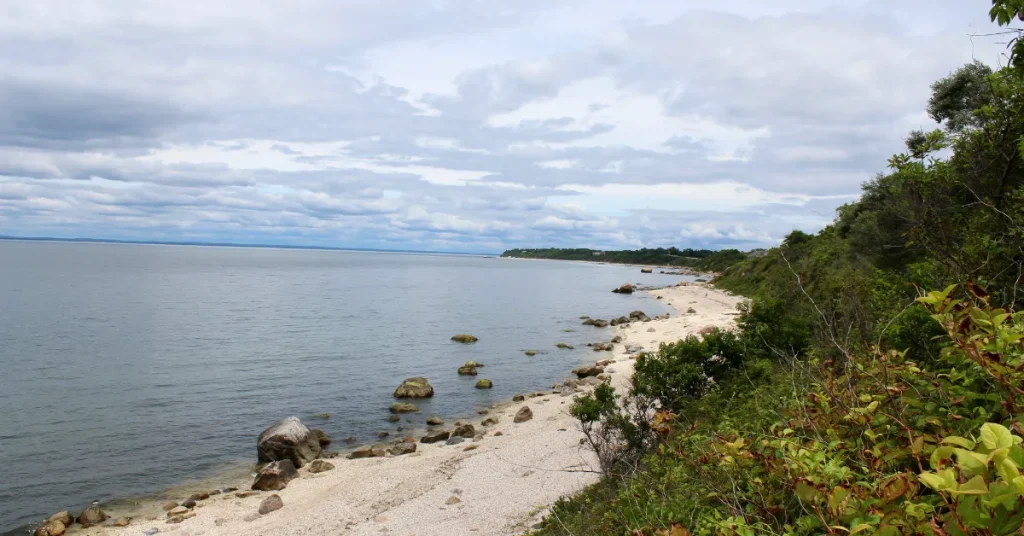The Long Island Sound has an average depth of about 63 feet. Its greatest depth is just over 300 feet.
Long Island Sound, a tidal estuary of the Atlantic Ocean, stretches between Connecticut to the north and Long Island to the south.
This geographical marvel supports busy marine navigation, diverse ecosystems, and numerous recreational activities. The Sound’s depth varies, making it accessible for a range of vessels, from small boats to larger ships.
Its relatively shallow average depth contributes to the rich marine life, as sunlight reaches the seabed in many areas, fostering an environment for underwater plants and animals.
Exploring the Long Island Sound offers an insight into the complex interplay between natural habitats and human influences along Northeastern shores.

Plunging Into Long Island Sound
Plunging into Long Island Sound promises an aquatic adventure rich with geographical marvels and surprising depths.
This serene body of water, nestled between Connecticut and Long Island, is a treasure trove for residents and travelers alike, eager to explore its expansive reach and captivating natural environment.
Geographic Orientation
Long Island Sound stretches along the Northeastern coast, forming a natural border between Connecticut’s shoreline and the North Shore of Long Island, New York.
At its western end, the Sound connects to the East River in New York City. On the eastern front, it opens up to the Atlantic Ocean, merging with the waters of Block Island Sound.
- Western End: East River, New York City
- Eastern End: Block Island Sound, Atlantic Ocean
- North Shore: Connecticut
- South Shore: Long Island, New York
The Sound’s Dimensional Profile
The depths of Long Island Sound vary greatly, offering a dynamic underwater landscape. Averages place the depth at about 63 feet, with shallower waters near the coastlines and profound depths reaching up to 300 feet in certain areas known as ‘The Race’.
| Area | Average Depth (ft) | Maximum Depth (ft) |
| Near Shorelines | 20-30 | Varies |
| Central Basin | 60-120 | Varies |
| The Race | 250-300 | Up to 300 |
These variances in depth contribute to the Sound’s diverse habitats, supporting a spectrum of marine life and aquatic vegetation.
Historical Depth Measurements
The Long Island Sound, a bustling estuary, has captivated humans for centuries. Its depth, significant for navigation and habitat diversity, has a story revealed through historical depth measurements.
Let’s dive into the annals of oceanography to chart the depth evolution of this magnificent body of water.
Early Exploration Records
Long Island Sound’s depth has been a subject of interest since European explorers arrived. The Native Americans knew the waters well, but formal measurements began with dutch explorers in the 17th century.
Sailing ships needed safe passage, prompting the first depth soundings, which were rudimentary and recorded with lead lines.
Advancements In Oceanography
As time sailed forward, so did our understanding of the seas. The 19th and 20th centuries witnessed significant strides in oceanography. Innovative tools like echo sounders replaced the old lead lines.
Detailed charts emerged, thanks to these technologies. The sound’s average depth is approximately 63 feet (19 meters), with certain areas plunging to over 300 feet (91 meters).
| Century | Average Depth Recorded | Maximum Depth Recorded |
| 17th | Unknown Variances | Relatively Shallow |
| 19th | 60-65 feet | 200+ feet |
| 20th | 63 feet (19 meters) | 320 feet (98 meters) |
Advanced mapping techniques now give us a precise underwater terrain model. These comprehensive data guide modern vessels safely through the Sound’s waters.
Ecology Beneath The Waves

Exploring the Ecology Beneath the Waves of the Long Island Sound reveals a world as complex and dynamic as the land above.
It’s a liquid tapestry woven with diverse life forms. Let’s take a deep dive into the underwater realm, marvel at the marine ecosystem, and understand the critical importance of preserving this natural wonder.
Marine Life Habitat
The Long Island Sound’s depths create an extraordinary habitat for marine life. These waters host:
- Colorful anemones
- Schools of fish
- Graceful sea turtles
- Scuttling crustaceans
Life thrives from the seafloor to the surface. Seagrasses sway in the currents, offering nursery grounds for young fish. Ecosystems around shipwrecks and natural reefs bustle with activity, forming complex habitats.
Conservation Efforts
To protect this precious underwater world, conservation efforts are crucial.
Key initiatives include:
- Monitoring water quality
- Protecting endangered species
- Restoring habitats
- Regulating fishing practices
Organizations actively engage communities, ensuring a collective effort towards a healthy Long Island Sound. Together, steps are taken to maintain the sound’s ecological balance, keeping the biodiversity intact for generations.
Modern Exploration Technologies
Exploring the depths of Long Island Sound today is a high-tech adventure. New technologies provide a clearer picture than ever before.
Sonar And Submersible Drones
Sonar technology bounces sound waves off the seafloor. This creates a map of what lies beneath the surface. With this technology, scientists can detect underwater features and changes in depth.
Submersible drones go where humans can’t. They take high-resolution images and collect data. These drones can dive deep into the Sound’s waters. They reveal the mysteries hidden below.
- Submersible drones are remote-controlled
- They capture live footage of underwater life
- Drones help in research and conservation efforts
Satellite Monitoring
Satellites in space watch over Long Island Sound. They track environmental changes and measure water quality.
These eyes in the sky monitor the Sound’s health. They provide valuable data for scientists and policymakers.
| Satellite Monitoring Uses |
| Tracking algal blooms |
| Observing water currents |
| Measuring water temperatures |
Impacts Of Human Activities
The health of the Long Island Sound is a reflection of human behavior. Activities along its shoreline and within its waters have significant effects. Let’s explore these impacts.
Pollution Levels
Human activities cause pollution in the Sound. Fertilizers run off from lawns and farms. They carry nutrients into the water. This can cause algae to grow too much. When algae die, they use up oxygen. Fish and other animals can’t live without oxygen.
Waste from boats and the mismanagement of waste on land add to the problem. Trash, especially plastics, harm wildlife. Birds and fish mistake them for food. Toxins from industries also find their way into the Sound.
| Source of Pollution | Impact on Long Island Sound |
| Fertilizer Runoff | Increases Nutrient Levels, Causes Algal Blooms |
| Waste Disposal | Depletes Oxygen, Endangers Marine Life |
| Trash (Plastics) | Threatens Wildlife, Causes Ingestion and Entanglement |
| Industrial Toxins | Poisons Ecosystem, Affects Water Quality |
Shipping And Trade
Shipping is vital for trade in the area. The Sound sees lots of boat traffic. Container ships and tankers travel through often. This creates waves and stirs up the sediment. The water becomes cloudy. Sunlight can’t get through. Plants under the water can’t grow.
Huge boats also bring in species not from the area. These are called invasive species. They can crowd out the local ones. This changes the ecosystem. It’s not always good for the Sound.
- Increased Boat Traffic
- Sediment Disruption and Cloudy Waters
- Introduction of Invasive Species
The Sound’s Role In Local Mythology

The Long Island Sound, a blend of history and mystery, ripples with tales older than the waters themselves. Its depths are home to more than marine life; they cradle stories that have woven their way into local mythology, captivating the imagination of those who walk its shores.
Legend Of The Lady In Blue
Among the whispers of the waves, the Legend of the Lady in Blue emerges as a chilling tale. It is said that a ghostly figure in a tattered blue gown roams the Sound’s misty edge. She is a search for her lost love, a sailor swallowed by the sea.
On quiet nights, her mournful wails merge with the wind, a haunting reminder of the Sound’s mythic past.
Tales From The Deep
The Sound holds secrets in its depths. Tales from the Deep speak of sunken ships and hidden treasures. Divers and fishermen share stories of eerie encounters and strange sightings beneath the surface.
- Shipwrecks: Many vessels met their end in these waters, fueling tales of ghost ships.
- Marine Mysteries: Unexplained sounds and sightings suggest the presence of ancient creatures.
- Hidden Riches: Rumors of long-lost loot continue to lure treasure hunters to the Sound.
FAQs About How Deep Is The Long Island Sound
What Is The Average Depth Of Long Island Sound?
The average depth of Long Island Sound is approximately 63 feet, with certain areas reaching deeper levels.
How Deep Can Long Island Sound Get?
The deepest parts of Long Island Sound can reach up to 300 feet, notably in a narrow trench known as The Race.
Where Is The Shallowest Part Of Long Island Sound?
The western end of Long Island Sound tends to be the shallowest, with depths generally less than 20 feet.
Does Long Island Sound Have Any Deepwater Ports?
Yes, Long Island Sound has several deepwater ports, with Bridgeport and New Haven being notable examples.
Conclusion
As we have explored, the Long Island Sound’s varied depths play a crucial role in its biodiversity and coastal dynamics.
Its average depth of 63 feet, reaching up to 300 feet at its deepest, makes this estuary a fascinating subject for marine enthusiasts and environmentalists alike.
Remember, whether sailing or studying, respecting these waters ensures they remain vibrant for generations.
Resources:
1. https://www.usgs.gov/tools/overview-long-island-sound
